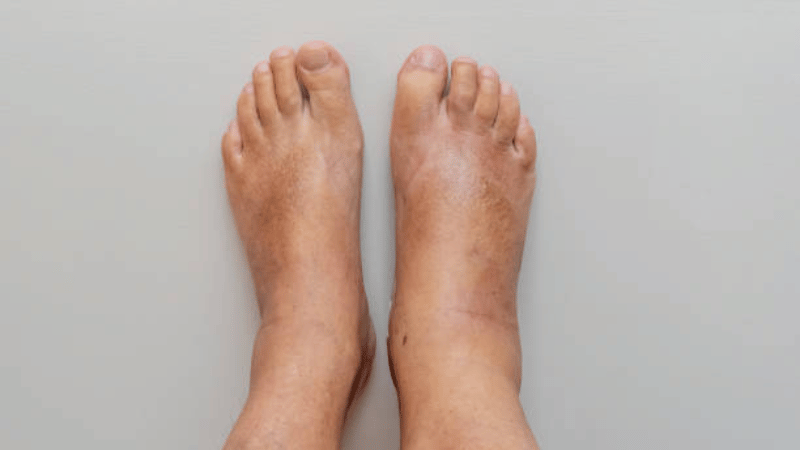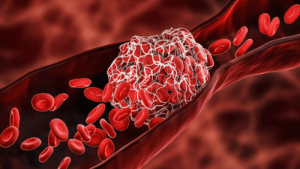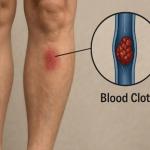
Most people have experienced puffy, swelling ankles after a long day on their feet. While it’s a common experience, knowing when ankle swelling might be a sign of something more serious, such as a blood clot is important. Let’s explore the causes, symptoms and when to seek medical attention.
Ankle swelling, or edema, occurs when excess fluid builds up in the tissues around the ankle. This can happen for several reasons, including circulation problems, injuries, medications, underlying medical conditions or lifestyle factors.
If you are concerned about swollen ankles and have visible varicose veins, talking with a vein specialist before symptoms worsen can provide the best patient outcome.
Schedule Your Health Consultation Today
Ankle Swelling from a Blood Clot — What Are the Risks?
The most serious cause of swelling in the ankle is a blood clot. A blood clot can become life-threatening if it’s in a deep vein.
A clot in a deep vein is called deep vein thrombosis (DVT). This type of blood clot, typically in the leg, requires immediate medical attention as it can block blood flow, leading to swelling and pain and a potentially life-threatening condition called a pulmonary embolism.
Complications from DVT: What You Need to Know
Normal, healthy blood flow moves through the veins, carrying deoxygenated blood toward the heart. Once blood reaches the heart, it is pumped into the lungs to pick up oxygen and then returns to the heart, which recirculates the blood throughout the body.
With DVT, blood flow is obstructed because the clot takes up part of the space in the blood vessel.
This can cause a condition called post-thrombotic syndrome, which occurs when blood pressure dramatically increases because of the clot. This causes inflammation and damage to delicate vein valves and other tissues.
Symptoms of post-thrombotic syndrome include leg pain, swelling, skin changes including venous ulcers, and leg heaviness.¹
DVT can also become a pulmonary embolism if all or part of the clot breaks off the vein wall and then travels to the lungs. If the embolism becomes lodged in the lungs, it can block blood flow and prevent the blood from gathering oxygen. This is a life-threatening condition that requires immediate medical attention.
Symptoms include shortness of breath, sharp chest pain that worsens with breathing, feeling faint, and coughing up blood.²
Signs and Symptoms that Ankle Swelling Is From a Blood Clot
If ankle swelling is from a blood clot, that’s unquestionably a severe situation because a possible case of DVT means a risk of dangerous complications. But how do you know if a swollen ankle is a sign of a blood clot?
Ankle swelling from a blood clot will only impact the affected leg, and the other leg should look normal. In addition to swelling, other symptoms include the following:
- Sharp pain or tenderness in the ankle, leg, or foot
- Warmth around the affected area
- Redness or the skin might become bluish or pale
- Cramping in the affected leg
Many factors, including poor circulation, a recent injury or surgery, and high estrogen levels, can increase the chance of developing a blood clot.
Other Ankle Swelling Causes
Swelling in the ankles results from fluid buildup in the tissues of the feet and ankles. An abnormal fluid buildup, also called edema, can happen for numerous reasons. While a blood clot is the most serious reason for a swollen ankle, other possible reasons exist.
Varicose Veins
Swelling of the ankles, legs, and feet is a symptom of early-stage chronic venous insufficiency, which is the root cause of varicose veins.
When your veins are damaged and unable to pump blood back up to your heart because of venous insufficiency, blood can pool in your legs, causing fluid build-up.
Schedule a Consultation With a Vein Specialist
Sedentary Lifestyle
Standing or sitting for long periods can cause swelling. If you are in the same position for hours (sitting or standing), your veins and muscles struggle to complete their work of pumping blood and body fluids up toward your heart. And when they can’t get those fluids up there, you’ll likely find your legs swell up as a result.
This is especially true when the weather is warm. Heat causes blood vessels to dilate, which, through gravity, brings more fluid to the ankles, legs, and feet.
Liver Disease
One symptom of liver disease is low levels of albumin, a protein made by the liver. This protein keeps fluid from leaking out of blood vessels and into tissues surrounding those vessels.
If the body struggles to produce enough liver proteins, fluids may accumulate in tissues, leading to swelling.
Medication Side Effect
Some medications can cause swollen ankles. This can happen with antidepressants and birth control pills with estrogen, as well as testosterone pills.³
Pregnancy
Pregnancy can also cause ankle swelling. The body holds more water during pregnancy, and extra fluid accumulates in the lower extremities. In these cases, raising the feet can usually relieve the swelling. However, it can also be caused by an underlying health condition, such as varicose veins or liver disease.
What to Do if You Suspect a Blood Clot
If you suspect a blood clot in your ankle or leg, seek immediate medical attention. A doctor can diagnose and treat the clot to prevent complications. Treatment often involves blood thinners, but physical removal may be necessary in some cases.
Preventing Blood Clots With Early Detection
Even if ankle swelling isn’t due to a blood clot, it could be related to vein disease or varicose veins. Varicose veins increase the risk of DVT, so it’s recommended to treat vein disease early on. They can also cause throbbing leg pain, leg fatigue, and venous ulcers. Schedule a consultation with a vein specialist to learn about treatment options for varicose veins and spider veins.
USA Vein Clinics is America’s network of vein treatment experts. We have over 160 locations nationwide and are staffed by highly renowned vein doctors committed to providing patient-centered care. If you’re concerned about ankle swelling and the risk of blood clots, schedule a consultation at a vein clinic near you today.
Frequently Asked Questions
Should I worry about swollen ankles?
Swollen ankles could indicate an underlying health condition, such as vein disease, also called chronic venous insufficiency. They can also be a warning sign of a blood clot, especially if only one ankle is swollen and there are other symptoms of a blood clot, such as pain, warmth, and redness.
What are ways to prevent a blood clot?
Regular exercise, staying hydrated, and getting regular vein check-ups if you have a history of vein problems can all help prevent blood clots from forming.
What happens when you get a blood clot in your ankles?
When someone has a blood clot in their ankles, blood flow is partially blocked, leading to symptoms such as ankle swelling and leg cramps.
A blood clot in the ankle can travel through your veins and cause serious complications, including vein inflammation and damage and a pulmonary embolism, so it is important to see a doctor if you suspect a blood clot. A blood clot in the leg, known as deep vein thrombosis (DVT), can potentially lead to amputation.
Sources:
- Jeffrey J Farrell, Christopher Sutter, Sidartha Tavri, & Indravadan Patel, “Incidence and interventions for post-thrombotic syndrome,” Cardiovascular Diagnosis and Therapy, https://doi.org/10.21037/cdt.2016.11.22
- Vrinda Vyas, Abdulghani Sankari, & Amandeep Goyal, “Acute pulmonary embolism,” StatPearls [Internet], StatPearls Publishing, https://www.ncbi.nlm.nih.gov/books/NBK560551/
- Jacob Berman, “Foot, leg, and ankle swelling,” University of Florida Health, https://ufhealth.org/conditions-and-treatments/foot-leg-and-ankle-swelling







